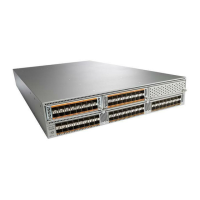The no-credit timeout feature is disabled by default. We recommend that you retain the default configuration
for ISLs and configure a value that does not exceed 358 ms (200 to 300 ms) for fabric F ports.
You can disable this feature by entering the no system timeout no-credit-drop mode F command.
The no-credit timeout value and stuck frame timeout value are interlinked. The no-credit timeout value
must always be greater than the stuck frame timeout value.
Note
SUMMARY STEPS
1.
switch# configure terminal
2.
switch(config)# system timeout no-credit-drop seconds mode F
3.
switch(config)# system timeout no-credit-drop default mode F
DETAILED STEPS
PurposeCommand or Action
Enters global configuration mode.switch# configure terminal
Step 1
Specifies the no-credit timeout value and port mode for the
switch. The seconds value is 500ms by default. This value can
be incremented in steps of 100.
switch(config)# system timeout no-credit-drop
seconds mode F
Step 2
Specifies the default no-credit timeout value port mode for the
switch.
switch(config)# system timeout no-credit-drop
default mode F
Step 3
This example shows how to configure a no-credit timeout value:
switch# configure terminal
switch(config)# system timeout no-credit-drop 100 mode F
switch(config)# system timeout no-credit-drop default mode F
Displaying Credit Loss Counters
Use the following commands to display the credit loss counters per module per interface for the last specified
minutes, hours, and days:
PurposeCommand
Displays Onboard Failure Logging (OBFL) credit
loss logs.
show process creditmon {credit-loss-event-history
| credit-loss-events | force-timeout-events |
timeout-discards-events}
Cisco Nexus 5000 Series NX-OS SAN Switching Configuration Guide, Release 5.2(1)N1(1)
OL-27583-01 297
Fibre Channel Slow Drain Device Detection and Congestion Avoidance- An Overview
Configuring a No-Credit Timeout Value

